Sahatany Valley is one of the mostfamous and important pegmatite fieldsand sources of gemstones and specimens,especially for tourmalines, inMadagascar and the whole of Africa forthat matter. Important diggings formulticolored and red tourmaline gemstonesand specimens have been documentedsince the beginning of the20th century. Decades of mining, whichremoved most of the easily accessibleparts of the pegmatites, have left modernday miners only the more difficultto reach deposits. Hence, the discoveryof extraordinary pockets is now ararity.
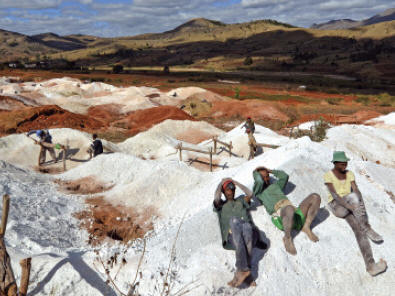
Miners working in Estatoby pegmatite in Sahatany Valley, Madagascar, resting after work. J. Gajowniczek photo.
This is one of the reasons that anexceptional find of a huge pocket containingwell formed, multi-color, andgemmy liddicoatite crystals in mid 2012was so surprising and caused tourmalinefever in the area. Crystals from thatfind are without doubt some of the best known from Madagascar and also someof the best known liddiocatites in theworld.
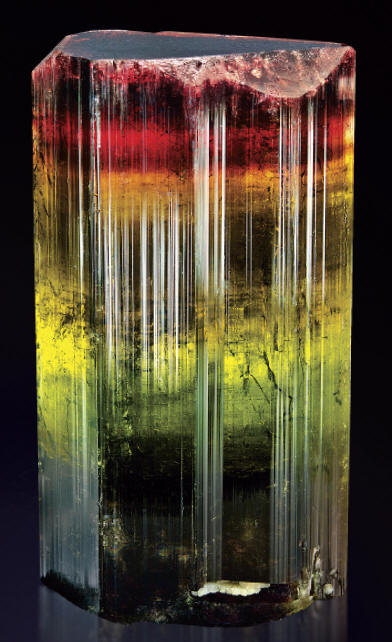
Huge, multicolor liddicoatite crystal from Estatoby, Madagascar; 14 cm in length. Watzl Minerals specimen. A. Watzl Sr. photo.
LOCATION AND GEOLOGY
Madagascar is very rich in pegmatitesand gem deposits because of itscomplicated geological history. The centraland eastern parts of Madagascar area shield built of Precambrian metamorphicand magmatic rocks. In some areasthese rocks were heavily intruded bymagma during the Pan-African Orogeny.

Sahatany Valley in central Madagascar is one of the most famous and productive pegmatite fields. J. Gajowniczek photo.
In Madagascar, the consequence of thislong-lasting and multi-stage process isan abundance of large pegmatite fieldsand pegmatite rich areas of an extremelyvaried chemical and mineralogical composition.
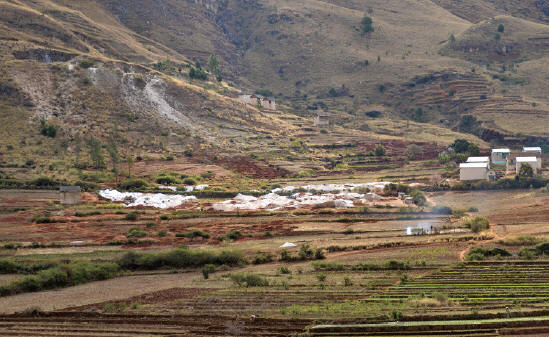
View of Estatoby workings (white dumps) and Vietnam workings located above. J. Gajowniczek photo.
Sahatany Valley is one of the mostfamous and best described pegmatitefields in Madagascar which is still productive.
The valley is formed by the smallSahatany River and is about 30 kilometerslong and quite wide. It is situated atthe foot of Ibity Mountain (2292 m high),about 30 km SSW from Antsirabe, a relativelylarge town and the center for mineraland gems dealing.
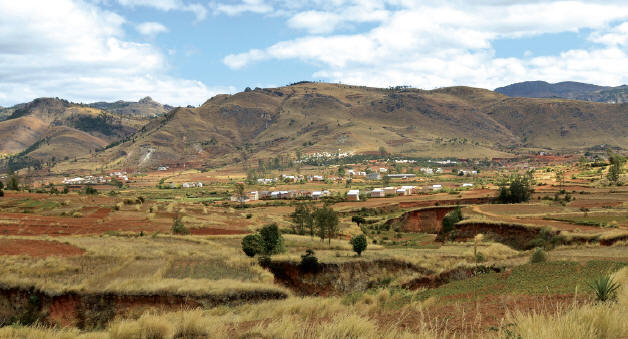
View of the central part of the Sahatny Valley with white dumps of the Tsarafara and Estatoby workings. J. Gajowniczek photo.
The center of the valley is about aone hour drive from Antsirabe by mainroad (RN 7) and then a local road to the Ibity village. From Ibity it is about a onehour walk to reach the main pegmatitefield. Sahatany Valley is considered oneof the more easily accessible Malagasymineral localities. The majority of localitiesin Madagascar are very difficult toreach even by 4x4 vehicle. For this reason,Sahatany Valley is one of the mostpopular destinations for mineral collectorsand local and foreign dealers.

Map of Madagascar showing inserts of the Sahatany Valley area and the location of the pegmatites in the area (white color) including Estatoby pegmatite (red).
Geologically, Sahatany Valley is locatedin the eastern part of the Itremotectonic unit, which is composed of metamorphicrocks including schists, quartzites,gniesses, and marbles. This widevariety of rock types, each with a differentdegree of resistance to erosion,results in a diverse landscape – thequartzites being the most resistant toweathering build the high jagged Ibityand Kiboy Mountains, while the marblesand schists form gentle hills and valleybottoms.
The geology of the area is additionallycomplicated by the occurrence ofgranitoids and gneisses, probably composingan old crystalline basement underlying the original sedimentary sequence,and by the intrusion of gabbroicand granitoid plutons. Gem bearing pegmatitesvery likely belong to the samemagmatic cycle which generated granitoidplutons, dated to be about 530 mya(Neoproterozoic age).

Kids in the Sahatanny Valley are always excited to see white people visiting the area. J. Gajowniczek photo.
The Sahatany Valley pegmatite fieldextends over 150 square kilometers andcontains more than 100 large pegmatiteswhich are typical vein pegmatites hostedin the marbles. The majority of pegmatitesoccurring in the SahantanyValley are of the Rare Element Class(LCT family – lithium-cesium-tantalum)with dominating subtypes: lepidolite,elbaite and “danburite”. A few of thembelong to the Beryl-Columbite Subtype.
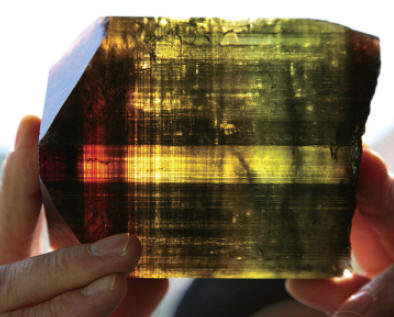
An 11 cm crystal of multicolor liddicoatite from Estatoby. M. Oleszczuk collection. F. Pezzotta photo.
The pegmatites dip at various angles,from almost horizontal to verticaland have a diverse relationship with the“bedding” of the host rocks, from concordantto discordant. They also rangein size from small (a few meters long) toquite large (several hundred meterslong).










 YueGongAnBei 44051102000467
YueGongAnBei 44051102000467


 |
|